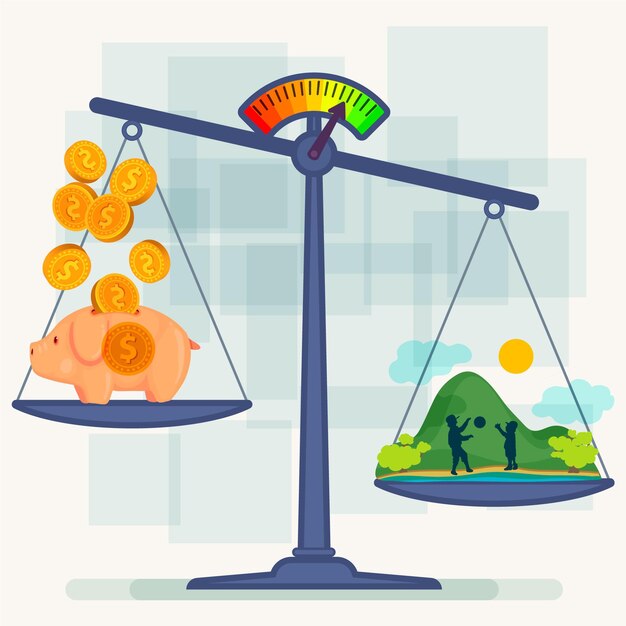Understanding Simple vs Compound Interest: Benefits, Formulas, and Examples
When it comes to making financial decisions, understanding the different types of interest that may affect our investments is crucial. A choice between simple and compound interest can have a significant impact on the growth of our savings or debt. So, let’s delve into these two intricately woven concepts and explore which one may offer better outcomes for our financial endeavors.
Firstly, let’s shed light on the concept of simple interest. This straightforward approach calculates interest solely based on the initial principal amount of a loan or investment. It remains constant over time, ensuring a predictable pattern allowing us to ascertain the exact interest gained or owed. However, while simple interest may offer simplicity and ease of calculation, it might not be the most advantageous option in terms of maximizing returns on our investments.
On the other hand, compound interest introduces an intriguing aspect to the world of interest calculations. It adds a layer of complexity by not only taking into account the principal amount but also considering the accumulated interest over time. The best part? Compound interest has the potential to multiply our savings or investments rapidly as interest keeps generating more interest. It allows our funds to grow exponentially, providing us with the possibility of higher returns in the long run.
Understanding the Basics of Simple and Compound Interest
In this section, we will delve into the fundamental concepts underlying both simple and compound interest. Exploring the fundamental principles of these two types of interest allows us to grasp their differences and understand their implications in financial and investment decisions.
Interest refers to the additional sum of money that is paid or earned when investing or borrowing funds. It serves as a form of compensation for the use of money over time. Understanding how interest works is essential in making informed financial choices.
Simple interest is a straightforward method of calculating interest based solely on the initial principal amount and a fixed interest rate. It does not take into account any interest that may have accrued over time. This type of interest is often used for short-term investments or loans.
Compound interest, on the other hand, incorporates the concept of interest compounding over time. In compound interest calculations, the interest earned or charged is added to the principal at fixed intervals, resulting in a continuously increasing total value. This compounding effect can lead to exponential growth and is often used for long-term investments or loans.
Understanding the differences between simple and compound interest is crucial to making informed financial decisions. By comprehending the underlying principles of these two types of interest, individuals can choose the most suitable option based on their goals, risk tolerance, and investment horizons.
Calculating Interest: Exploring the Differences
Understanding the Variations in Interest Calculation
In the realm of finance, the calculation of interest plays a crucial role in determining financial growth and profitability. This section delves into the distinctions that exist between two types of interest: simple and compound. By examining the contrasting methodologies employed in the calculation of these interest rates, we can gain a deeper understanding of their impact on financial investments and loans.
Defining Simple Interest
Simple interest refers to a straightforward method of calculating interest based solely on the principal amount and the predetermined interest rate. With this approach, the interest remains constant throughout the specified term, and there is no compounding involved. However, it is important to note that while simple interest may seem less complex, it may also result in lower earnings compared to compound interest.
Exploring Compound Interest
Compound interest, on the other hand, introduces the concept of periodic reinvestment of both principal and accrued interest. As interest is compounded over time, the investment or loan grows exponentially. This compounding effect allows for potentially higher returns or increased interest obligations, depending on the context. Compound interest enables the concept of “earning interest on interest,” which can lead to significant financial gains over extended periods.
Comparing the Advantages and Disadvantages
When it comes to measuring the benefits and drawbacks of simple and compound interest, various factors must be considered. Simple interest provides predictability and simplicity in its calculation, making it easier to understand for many individuals. However, compound interest offers the potential for accelerated growth and higher returns, particularly over long-term investments. Nevertheless, it is essential to recognize the potential drawbacks, such as the higher overall interest payment associated with loans using compound interest.
Conclusion
Understanding the differences between simple and compound interest calculation methods is crucial for making informed financial decisions. While the simplicity of simple interest may be appealing, compound interest has the potential for significant long-term growth and returns. By considering the specific context and goals of an investment or loan, individuals can determine which type of interest calculation best suits their needs.
Time Horizon: Impact on Interest Earnings
The length of time an investment is held can significantly affect the amount of interest earnings. This section will explore how the duration of the investment impacts the accumulation of interest without directly comparing simple and compound interest. By examining the influence of the time horizon on interest earnings, we can gain a better understanding of how to maximize returns.
| Time Horizon | Interest Earnings |
|---|---|
| Short-term | For investments with a brief time horizon, the interest earned might be relatively low. This is due to the limited opportunity for the interest to accumulate and compound over time. However, short-term investments can provide quick returns and flexibility. |
| Medium-term | Investments held for a moderate duration can potentially generate higher interest earnings compared to short-term investments. This is because the funds have more time to accrue interest and, in the case of compound interest, can benefit from interest compounding. |
| Long-term | Long-term investments have the potential to generate substantial interest earnings. With a more extended time horizon, there is ample opportunity for compound interest to work its magic. Over a significant period, even a slight difference in interest rates can result in substantial growth. Long-term investments are often associated with retirement savings and wealth accumulation. |
It is important to note that the time horizon alone is not the sole determinant of interest earnings. Factors such as interest rates, compounding frequency, and the initial principal also play significant roles. However, understanding the impact of the time horizon on interest earnings is crucial in making informed investment decisions.
Risk and Return: Assessing the Trade-offs
Exploring the relationship between risk and return is crucial when making financial decisions. In this section, we will delve into the trade-offs associated with different levels of risk and return, without directly comparing simple and compound interest. Understanding these trade-offs can help individuals make more informed choices, considering their risk tolerance and desired financial outcomes.
The Concept of Risk
When it comes to investments, risk refers to the uncertainty of achieving expected returns. It involves the possibility of losing some or all of the invested capital. The degree of risk varies across different asset classes and investment vehicles. Higher-risk investments often promise higher potential returns, but also carry a greater chance of loss.
Return and Reward
Return, on the other hand, represents the overall gain or loss on an investment over a specific period. It includes not only the initial amount invested but also the income generated from the investment, such as interest, dividends, or capital gains. Investors generally aim for higher returns as they seek to grow their wealth.
Assessing the trade-offs between risk and return is crucial. While higher-risk investments may provide the potential for greater returns, they also come with a higher chance of losing money, especially in volatile markets. Conversely, lower-risk investments typically offer more stable returns but at the cost of potentially lower overall growth.
- Investors with a higher risk tolerance may choose to allocate a portion of their portfolio to higher-risk investments to potentially achieve higher returns.
- Investors with a lower risk tolerance may prioritize capital preservation and opt for lower-risk investments, even if it means sacrificing potential growth.
It’s important to note that the optimal balance between risk and return may vary for each individual, depending on their financial goals, time horizon, and risk tolerance. Choosing the appropriate mix of investments involves considering these factors and assessing the trade-offs between risk and potential rewards.
Finally, it’s worth mentioning that diversification, or spreading investments across different asset classes, can help mitigate risk. This strategy aims to reduce the impact of poor performance in one investment by potentially offsetting it with positive performance in another, thereby minimizing overall portfolio risk.
Real-life Applications: Identifying the Appropriate Interest Type
When it comes to making financial decisions, it is essential to understand the implications of different interest types. By exploring real-life applications, we can gain insight into which interest type makes the most sense. Let’s delve into various scenarios and examine the advantages and disadvantages of simple and compound interest.
Investments
- Long-term Investments: If you are considering a long-term investment strategy, compound interest may be the better option. The compounding effect allows your investment to grow exponentially over time, resulting in higher returns.
- Short-term Investments: On the other hand, for short-term investments where access to funds is crucial, simple interest might be more suitable. Simple interest offers straightforward calculations, eliminating the complexity of compounding.
Borrowing
- Loans: When borrowing money, whether for personal reasons or business ventures, simple interest can be advantageous. With simple interest, the fixed interest rate allows you to have a clear understanding of your repayment obligations.
- Mortgages: On the contrary, compound interest is commonly used for mortgage loans. Over a long repayment period, compound interest can result in significant savings, as the interest is continually calculated based on the outstanding loan balance.
Ultimately, the choice between simple and compound interest depends on your financial goals, time horizon, and specific circumstances. By considering the real-life applications mentioned above and evaluating the advantages and disadvantages of each type, you can make an informed decision that aligns with your financial objectives.
Questions and answers: Simple vs compound interest
What is the difference between simple interest and compound interest?
Simple interest is calculated only on the principal amount, while compound interest is calculated on the principal amount as well as the accumulated interest from previous periods.
Which type of interest results in higher returns?
Compound interest tends to generate higher returns compared to simple interest because it takes into account the accumulated interest from previous periods. This allows for continuous growth of the investment.
Are there any advantages to choosing simple interest over compound interest?
One advantage of simple interest is that it is easier to calculate and understand. Additionally, simple interest may be more suitable for short-term loans or investments where the compounding effect is not significant.
Can you provide an example to illustrate the difference between simple and compound interest?
Let’s say you invest $1000 at an interest rate of 5% for 5 years. With simple interest, you would earn $250 in interest each year, totaling $1250 at the end of 5 years. However, with compound interest, your investment would grow to $1276.28 due to the compounding effect.
Which type of interest is commonly used by banks and financial institutions?
Banks and financial institutions commonly use compound interest because it allows for greater returns over time. This allows them to earn more interest on loans and investments, resulting in higher profits.
What is the difference between simple and compound interest?
Simple interest is calculated only on the initial amount of money invested, while compound interest is calculated on both the initial amount and any accumulated interest.
What is a savings account, and how does it differ from other types of accounts?
A savings account is a type of bank account where individuals can deposit and store their money while earning interest on the balance. Unlike checking accounts, savings accounts typically offer higher interest rates and are primarily used for long-term savings goals.
What is annual interest, and how is it calculated for a savings account?
Annual interest refers to the amount of interest earned on a savings account balance over one year. It is calculated based on the account’s annual interest rate and the amount of money deposited into the account.
How do banks typically pay interest on savings accounts?
Banks typically pay interest on savings accounts either monthly, quarterly, or annually, depending on the bank’s policies and the type of account.
What is an annual interest rate, and why is it important for savings accounts?
The annual interest rate is the percentage of interest that a savings account earns on its balance over the course of one year. It is important for savings accounts as it determines how much interest will be accrued on the deposited funds.
How is interest paid on a savings account different from interest earned on other investments?
Interest paid on a savings account is typically lower than the returns earned on other investments such as stocks, bonds, or mutual funds. However, savings accounts offer greater stability and security of funds compared to investment options with higher risks.
What role does a calculator play in understanding the potential earnings from a savings account?
A calculator helps individuals estimate the potential earnings from a savings account by inputting variables such as the account balance, annual interest rate, and compounding frequency to calculate the total interest earned over time.
What is APY, and how does it differ from the annual interest rate?
APY, or Annual Percentage Yield, represents the total amount of interest earned on a savings account, including compound interest, expressed as a percentage. It differs from the annual interest rate as it accounts for compounding, providing a more accurate measure of the account’s overall earning potential.
How is the annual percentage yield (APY) calculated for a savings account?
The annual percentage yield (APY) for a savings account is calculated by considering the annual interest rate and how often the interest is compounded within the year. It provides a more comprehensive understanding of the account’s earnings potential.
Why is it essential for savers to consider both the annual interest rate and the APY when evaluating savings accounts?
It is essential for savers to consider both the annual interest rate and the APY when evaluating savings accounts because while the annual interest rate indicates the base rate of interest earned, the APY accounts for compounding, providing a more accurate reflection of the account’s overall growth.
How does understanding the annual percentage yield (APY) help savers make informed decisions about their savings accounts?
Understanding the APY helps savers make informed decisions by allowing them to compare the overall earning potential of different savings accounts accurately. By considering the APY, savers can choose accounts that offer the best combination of interest rates and compounding frequency to maximize their savings growth.
What is the difference between simple interest and compound interest?
Simple interest is calculated solely on the principal amount, while compound interest takes into account both the principal and the accumulated interest.
When would simple interest be better than compound interest?
Simple interest may be preferable for short-term loans or investments where the interest rate is low, and the interest is not compounded over time.
How is the interest charged on a simple interest loan?
On a simple interest loan, the interest is calculated based on the principal amount and the annual interest rate, without consideration for compounding.
What are the main characteristics of simple and compound interest loans?
In a simple interest loan, the interest is calculated only on the principal amount, whereas in a compound interest loan, interest accrues on both the principal and any previously accumulated interest.
How does a compound interest calculator help in financial planning?
A compound interest calculator assists in estimating the growth of an investment or loan over time by considering factors such as the principal amount, interest rate, compounding frequency, and duration.
Which type of interest—simple or compound—typically yields more interest over time?
Compound interest usually yields more interest over time compared to simple interest, especially for long-term loans or investments, due to the compounding effect.
What are some examples of financial products that pay simple interest?
Personal loans, car loans, and some certificates of deposit (CDs) are examples of financial products that may pay simple interest.
How does compound interest work for savings accounts and investments?
In savings accounts and investments, compound interest works by reinvesting the earned interest back into the account or investment, allowing the balance to grow exponentially over time.
Can you explain how compound interest accrues over the term of a loan?
Compound interest accrues over the term of a loan by adding the accumulated interest to the principal balance, resulting in interest being charged on a progressively increasing amount.
What factors influence whether simple interest or compound interest is better for a particular financial scenario?
Factors such as the duration of the loan or investment, the interest rate, and the compounding frequency all play a role in determining whether simple or compound interest is more advantageous in a specific financial situation.








No responses yet